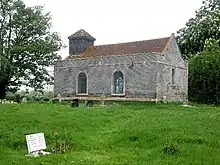Old All Saints Church, Great Steeping
Old All Saints Church is a redundant Anglican church in the village of Great Steeping, Lincolnshire, England. It is recorded in the National Heritage List for England as a designated Grade II* listed building,[1] and is under the care of the Churches Conservation Trust.[2] The church stands in marshland, surrounded by a medieval field system, at the end of a lane leading south from the B1195 road, some 3 miles (5 km) southeast of Spilsby.[2][3]
| Old All Saints Church, Great Steeping | |
|---|---|
 Old All Saints Church, Great Steeping, from the southeast | |
 Old All Saints Church, Great Steeping Location in Lincolnshire | |
| 53.1533°N 0.1441°E | |
| OS grid reference | TF 434 639 |
| Location | Great Steeping, Lincolnshire |
| Country | England |
| Denomination | Anglican |
| Website | Churches Conservation Trust |
| Architecture | |
| Functional status | Redundant |
| Heritage designation | Grade II* |
| Designated | 17 December 1987 |
| Architectural type | Church |
| Style | Georgian |
| Groundbreaking | 1748 |
| Completed | 1908 |
| Specifications | |
| Materials | Brick with limestone dressings and some greenstone Tiled roof |
History
The church was built in 1748 on the site of an earlier medieval church, and was restored in 1908.[1] However a new church, also dedicated to All Saints, was built nearer the centre of the village in 1891, and the old church was declared redundant in August 1973.[4]
Architecture
All Saints is constructed in brick with limestone dressings, on a plinth of greenstone rubble. The roof is tiled.[1] The architectural style is Georgian.[5] Its plan is simple, consisting of a nave and chancel under one roof, and a bellcote at the west end. The bellcote is rectangular and weatherboarded, with a pyramidal roof. At the west end of the church is a doorway with a moulded architrave and a raised keystone. Above this is a stone inscribed with the dates 1748 and 1908, and there is a band with a pediment above that. Along each side of the church are two semicircular-headed windows. Between the windows on the south side is a sundial. At the east end is a smaller semicircular-headed window, above which is the outline of the gable of the chancel of the earlier church.[1]
References
- Historic England, "Old Church of All Saints, Great Steeping (1267241)", National Heritage List for England, retrieved 31 August 2013
- All Saints' Church, Great Steeping, Lincolnshire, Churches Conservation Trust, retrieved 9 December 2016
- Great Steeping, Streetmap, retrieved 9 March 2011
- Great Steepling, Church History, GENUKI, retrieved 9 March 2011
- Great Steeping, All Saints Church, Britain Express, retrieved 9 March 2011